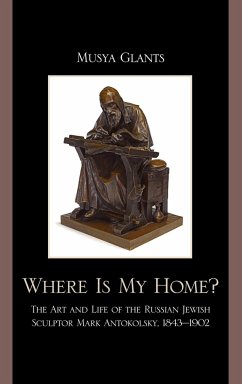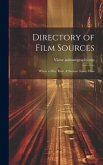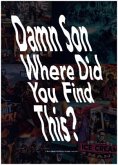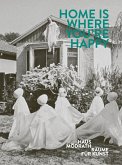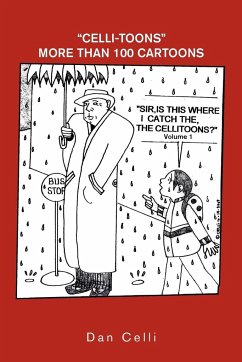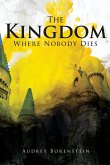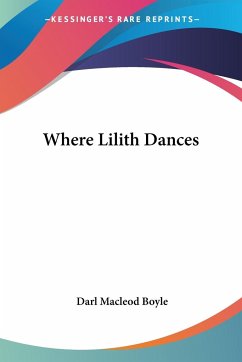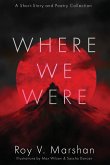Musya Glants
Where Is My Home?
The Art and Life of the Russian-Jewish Sculptor Mark Antokolskii, 1843-1902
Musya Glants
Where Is My Home?
The Art and Life of the Russian-Jewish Sculptor Mark Antokolskii, 1843-1902
- Gebundenes Buch
- Merkliste
- Auf die Merkliste
- Bewerten Bewerten
- Teilen
- Produkt teilen
- Produkterinnerung
- Produkterinnerung
Where Is My Home? is a biography of Mark Antokolski (1843-1902), one of the leading innovative sculptors in Russian and Western art of the late 19th century. This interdisciplinary study pays particular attention to his status as a great Jewish social figure as well as to the theme of national identity.
Andere Kunden interessierten sich auch für
![Directory of Film Sources: Where to buy, Rent, & Borrow 16mm Films Directory of Film Sources: Where to buy, Rent, & Borrow 16mm Films]() Victor Animatograph CorpDirectory of Film Sources: Where to buy, Rent, & Borrow 16mm Films28,99 €
Victor Animatograph CorpDirectory of Film Sources: Where to buy, Rent, & Borrow 16mm Films28,99 €![Damn Son Where Did You FInd This? A book about US hiphop mixtape cover art Damn Son Where Did You FInd This? A book about US hiphop mixtape cover art]() Damn Son Where Did You FInd This? A book about US hiphop mixtape cover art29,80 €
Damn Son Where Did You FInd This? A book about US hiphop mixtape cover art29,80 €![Home Is Where You're Happy Home Is Where You're Happy]() Gesine BorcherdtHome Is Where You're Happy39,00 €
Gesine BorcherdtHome Is Where You're Happy39,00 €![''Sir, Is This Where I Catch the Cellitoons?'' ''Sir, Is This Where I Catch the Cellitoons?'']() Dan Celli''Sir, Is This Where I Catch the Cellitoons?''21,99 €
Dan Celli''Sir, Is This Where I Catch the Cellitoons?''21,99 €![The Kingdom Where Nobody Dies The Kingdom Where Nobody Dies]() Audery BorensteinThe Kingdom Where Nobody Dies16,99 €
Audery BorensteinThe Kingdom Where Nobody Dies16,99 €![Where Lilith Dances Where Lilith Dances]() Darl Macleod BoyleWhere Lilith Dances17,99 €
Darl Macleod BoyleWhere Lilith Dances17,99 €![Where We Were Where We Were]() Roy V. MarshanWhere We Were15,99 €
Roy V. MarshanWhere We Were15,99 €-
-
-
Where Is My Home? is a biography of Mark Antokolski (1843-1902), one of the leading innovative sculptors in Russian and Western art of the late 19th century. This interdisciplinary study pays particular attention to his status as a great Jewish social figure as well as to the theme of national identity.
Hinweis: Dieser Artikel kann nur an eine deutsche Lieferadresse ausgeliefert werden.
Hinweis: Dieser Artikel kann nur an eine deutsche Lieferadresse ausgeliefert werden.
Produktdetails
- Produktdetails
- Verlag: Lexington Books
- Seitenzahl: 430
- Erscheinungstermin: 19. November 2010
- Englisch
- Abmessung: 240mm x 161mm x 28mm
- Gewicht: 807g
- ISBN-13: 9780739132999
- ISBN-10: 0739132997
- Artikelnr.: 29027472
- Herstellerkennzeichnung
- Libri GmbH
- Europaallee 1
- 36244 Bad Hersfeld
- gpsr@libri.de
- Verlag: Lexington Books
- Seitenzahl: 430
- Erscheinungstermin: 19. November 2010
- Englisch
- Abmessung: 240mm x 161mm x 28mm
- Gewicht: 807g
- ISBN-13: 9780739132999
- ISBN-10: 0739132997
- Artikelnr.: 29027472
- Herstellerkennzeichnung
- Libri GmbH
- Europaallee 1
- 36244 Bad Hersfeld
- gpsr@libri.de
Musya Glants is a fellow in the Davis Center for Russian Studies at Harvard University.
Chapter 1 Introduction: Mark Antokolskii and his role in Russian, Jewish,
and European Culture. Chapter 2 Chapter 1: Vilna. Childhood and youth.
Family and friends. Jewish life under Nicholas I and Alexander II:
religion, tradition, and the struggle for secularism and education; the
Jewish Enlightenment. Antokolskii's search for his own way in life and his
fi Chapter 3 Chapter 2: St. Petersburg. The Academy of Arts: a dream
fulfilled. The liberal atmosphere of the 1860s-early 1870s. Professors and
new friends. Il'ia Repin. Estrangement from classicism. The Russian
intellectual milieu. New friends outside the Academy. Th Chapter 4 Chapter
3: The strong links to home and Jewishness. Letters to Yakov Barel and the
hardship of life in the capital. Between past and present: the intensifying
sense of duality. Summer vacations at home. Images of Jews: "The Tailor"
(1864), "The Miser" (18 Chapter 5 Chapter 4: Towards a new style: "Ivan the
Terrible" (1871)-an innovative turn in Russian sculpture. The success and
the sweetness of fame. Serious Illness. Chapter 6 Chapter 5: Trip to Italy:
a window to the world. Rising hopes and inspirations. Life in Rome. Images
of Italy. New friends: the Mamontov family, the Polenovs. The Mamontov
circle. "Peter the Great" (1872). Marriage to Elena Apatova (1872). Chapter
7 Chapter 6: Disturbing news from the homeland: the growth of
anti-Semitism. The expanding feeling of dual belonging. The death of his
son Lev (1876). Search for his own style in sculpture. Christian images as
a reflection of his strong ideas to draw Jews a Chapter 8 Chapter 7:
Removal to Paris, 1877. Life in Paris. The Russian intellectual community.
The "Society of Russian Artists in Paris". I. Turgenev; A. Bogoliubov. Art
in Paris and French sculpture of that time. The portrait gallery; World
Exhibition, 1878 and A Chapter 9 Chapter 8: Exploring genres: distinctive
memorials (M. Obolenskaia, 1875-1877) and monuments, accomplished
(Catherine II, 1901-1902) and unrealized (A. Pushkin, 1875; I. Fiodorov).
Political reaction in Russia: persecution of Jews and pogroms. Visits to R
Chapter 10 Chapter 9: Images of Russian historical figures: "Nestor" (1890)
and "Yermak" (1891) as a silent call for national tolerance. Official and
unofficial manifestations of intensifying ill will towards the sculptor.
Antokolskii and his path to Modernism: a ne Chapter 11 Chapter 10: The late
1880s and 1890s: prolific last years. Triumph in Munich (1892). Extensive
writing. "Dreyfus". "Reminiscences of Italy". "Letter to H. Gintsburg." The
pain of lost ideals and illusions. Illness and death. The funeral-a
symbolic homecom Chapter 12 Conclusion: M. Antokolskii's human and artistic
fate as emblematic for an artist and a Jew in Late Imperial Russia.
and European Culture. Chapter 2 Chapter 1: Vilna. Childhood and youth.
Family and friends. Jewish life under Nicholas I and Alexander II:
religion, tradition, and the struggle for secularism and education; the
Jewish Enlightenment. Antokolskii's search for his own way in life and his
fi Chapter 3 Chapter 2: St. Petersburg. The Academy of Arts: a dream
fulfilled. The liberal atmosphere of the 1860s-early 1870s. Professors and
new friends. Il'ia Repin. Estrangement from classicism. The Russian
intellectual milieu. New friends outside the Academy. Th Chapter 4 Chapter
3: The strong links to home and Jewishness. Letters to Yakov Barel and the
hardship of life in the capital. Between past and present: the intensifying
sense of duality. Summer vacations at home. Images of Jews: "The Tailor"
(1864), "The Miser" (18 Chapter 5 Chapter 4: Towards a new style: "Ivan the
Terrible" (1871)-an innovative turn in Russian sculpture. The success and
the sweetness of fame. Serious Illness. Chapter 6 Chapter 5: Trip to Italy:
a window to the world. Rising hopes and inspirations. Life in Rome. Images
of Italy. New friends: the Mamontov family, the Polenovs. The Mamontov
circle. "Peter the Great" (1872). Marriage to Elena Apatova (1872). Chapter
7 Chapter 6: Disturbing news from the homeland: the growth of
anti-Semitism. The expanding feeling of dual belonging. The death of his
son Lev (1876). Search for his own style in sculpture. Christian images as
a reflection of his strong ideas to draw Jews a Chapter 8 Chapter 7:
Removal to Paris, 1877. Life in Paris. The Russian intellectual community.
The "Society of Russian Artists in Paris". I. Turgenev; A. Bogoliubov. Art
in Paris and French sculpture of that time. The portrait gallery; World
Exhibition, 1878 and A Chapter 9 Chapter 8: Exploring genres: distinctive
memorials (M. Obolenskaia, 1875-1877) and monuments, accomplished
(Catherine II, 1901-1902) and unrealized (A. Pushkin, 1875; I. Fiodorov).
Political reaction in Russia: persecution of Jews and pogroms. Visits to R
Chapter 10 Chapter 9: Images of Russian historical figures: "Nestor" (1890)
and "Yermak" (1891) as a silent call for national tolerance. Official and
unofficial manifestations of intensifying ill will towards the sculptor.
Antokolskii and his path to Modernism: a ne Chapter 11 Chapter 10: The late
1880s and 1890s: prolific last years. Triumph in Munich (1892). Extensive
writing. "Dreyfus". "Reminiscences of Italy". "Letter to H. Gintsburg." The
pain of lost ideals and illusions. Illness and death. The funeral-a
symbolic homecom Chapter 12 Conclusion: M. Antokolskii's human and artistic
fate as emblematic for an artist and a Jew in Late Imperial Russia.
Chapter 1 Introduction: Mark Antokolskii and his role in Russian, Jewish,
and European Culture. Chapter 2 Chapter 1: Vilna. Childhood and youth.
Family and friends. Jewish life under Nicholas I and Alexander II:
religion, tradition, and the struggle for secularism and education; the
Jewish Enlightenment. Antokolskii's search for his own way in life and his
fi Chapter 3 Chapter 2: St. Petersburg. The Academy of Arts: a dream
fulfilled. The liberal atmosphere of the 1860s-early 1870s. Professors and
new friends. Il'ia Repin. Estrangement from classicism. The Russian
intellectual milieu. New friends outside the Academy. Th Chapter 4 Chapter
3: The strong links to home and Jewishness. Letters to Yakov Barel and the
hardship of life in the capital. Between past and present: the intensifying
sense of duality. Summer vacations at home. Images of Jews: "The Tailor"
(1864), "The Miser" (18 Chapter 5 Chapter 4: Towards a new style: "Ivan the
Terrible" (1871)-an innovative turn in Russian sculpture. The success and
the sweetness of fame. Serious Illness. Chapter 6 Chapter 5: Trip to Italy:
a window to the world. Rising hopes and inspirations. Life in Rome. Images
of Italy. New friends: the Mamontov family, the Polenovs. The Mamontov
circle. "Peter the Great" (1872). Marriage to Elena Apatova (1872). Chapter
7 Chapter 6: Disturbing news from the homeland: the growth of
anti-Semitism. The expanding feeling of dual belonging. The death of his
son Lev (1876). Search for his own style in sculpture. Christian images as
a reflection of his strong ideas to draw Jews a Chapter 8 Chapter 7:
Removal to Paris, 1877. Life in Paris. The Russian intellectual community.
The "Society of Russian Artists in Paris". I. Turgenev; A. Bogoliubov. Art
in Paris and French sculpture of that time. The portrait gallery; World
Exhibition, 1878 and A Chapter 9 Chapter 8: Exploring genres: distinctive
memorials (M. Obolenskaia, 1875-1877) and monuments, accomplished
(Catherine II, 1901-1902) and unrealized (A. Pushkin, 1875; I. Fiodorov).
Political reaction in Russia: persecution of Jews and pogroms. Visits to R
Chapter 10 Chapter 9: Images of Russian historical figures: "Nestor" (1890)
and "Yermak" (1891) as a silent call for national tolerance. Official and
unofficial manifestations of intensifying ill will towards the sculptor.
Antokolskii and his path to Modernism: a ne Chapter 11 Chapter 10: The late
1880s and 1890s: prolific last years. Triumph in Munich (1892). Extensive
writing. "Dreyfus". "Reminiscences of Italy". "Letter to H. Gintsburg." The
pain of lost ideals and illusions. Illness and death. The funeral-a
symbolic homecom Chapter 12 Conclusion: M. Antokolskii's human and artistic
fate as emblematic for an artist and a Jew in Late Imperial Russia.
and European Culture. Chapter 2 Chapter 1: Vilna. Childhood and youth.
Family and friends. Jewish life under Nicholas I and Alexander II:
religion, tradition, and the struggle for secularism and education; the
Jewish Enlightenment. Antokolskii's search for his own way in life and his
fi Chapter 3 Chapter 2: St. Petersburg. The Academy of Arts: a dream
fulfilled. The liberal atmosphere of the 1860s-early 1870s. Professors and
new friends. Il'ia Repin. Estrangement from classicism. The Russian
intellectual milieu. New friends outside the Academy. Th Chapter 4 Chapter
3: The strong links to home and Jewishness. Letters to Yakov Barel and the
hardship of life in the capital. Between past and present: the intensifying
sense of duality. Summer vacations at home. Images of Jews: "The Tailor"
(1864), "The Miser" (18 Chapter 5 Chapter 4: Towards a new style: "Ivan the
Terrible" (1871)-an innovative turn in Russian sculpture. The success and
the sweetness of fame. Serious Illness. Chapter 6 Chapter 5: Trip to Italy:
a window to the world. Rising hopes and inspirations. Life in Rome. Images
of Italy. New friends: the Mamontov family, the Polenovs. The Mamontov
circle. "Peter the Great" (1872). Marriage to Elena Apatova (1872). Chapter
7 Chapter 6: Disturbing news from the homeland: the growth of
anti-Semitism. The expanding feeling of dual belonging. The death of his
son Lev (1876). Search for his own style in sculpture. Christian images as
a reflection of his strong ideas to draw Jews a Chapter 8 Chapter 7:
Removal to Paris, 1877. Life in Paris. The Russian intellectual community.
The "Society of Russian Artists in Paris". I. Turgenev; A. Bogoliubov. Art
in Paris and French sculpture of that time. The portrait gallery; World
Exhibition, 1878 and A Chapter 9 Chapter 8: Exploring genres: distinctive
memorials (M. Obolenskaia, 1875-1877) and monuments, accomplished
(Catherine II, 1901-1902) and unrealized (A. Pushkin, 1875; I. Fiodorov).
Political reaction in Russia: persecution of Jews and pogroms. Visits to R
Chapter 10 Chapter 9: Images of Russian historical figures: "Nestor" (1890)
and "Yermak" (1891) as a silent call for national tolerance. Official and
unofficial manifestations of intensifying ill will towards the sculptor.
Antokolskii and his path to Modernism: a ne Chapter 11 Chapter 10: The late
1880s and 1890s: prolific last years. Triumph in Munich (1892). Extensive
writing. "Dreyfus". "Reminiscences of Italy". "Letter to H. Gintsburg." The
pain of lost ideals and illusions. Illness and death. The funeral-a
symbolic homecom Chapter 12 Conclusion: M. Antokolskii's human and artistic
fate as emblematic for an artist and a Jew in Late Imperial Russia.

